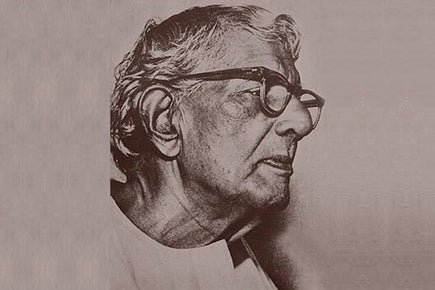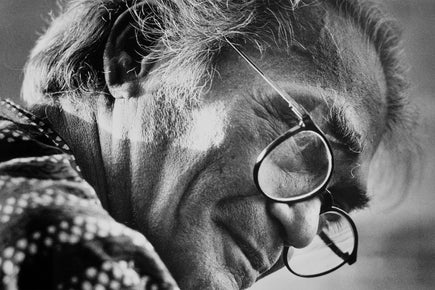Merging Modernity with Tradition - Celebrating the Art of S.H. Raza
SYED HAIDER RAZA (S.H. Raza) is a name that will always be etched in the annals of Indian Art. His paintings, with their mellifluous colours, resonate with a certain passionate intensity, making him one of India’s most celebrated artists.
 (Source: Kunal Kakodkar Photography, graziaindia)
(Source: Kunal Kakodkar Photography, graziaindia)
A League Above
Born on 22nd February 1922 in Babaria, Madhya Pradesh, Raza received the Padma Shri, Padma Bhushan, and Padma Vibhushan. He was also conferred with the highest French civilian honour, the ‘Commandeur de la Legion d’honneur’. His paintings ‘La Terre’ and ‘Saurashtra’ are among the most expensive works ever sold by an Indian artist, at Rs. 18.61 crores (roughly USD 31 million) and Rs. 16.42 crores (roughly USD 25 million) respectively. This also makes limited edition prints of Raza’s paintings hugely popular amongst art lovers.
 (Raza's seminal work, Saurashtra sold for Rs. 16.42 crores at a Christie's Auction in 2010)
(Raza's seminal work, Saurashtra sold for Rs. 16.42 crores at a Christie's Auction in 2010)
An alumnus of Nagpur School of Art and Sir J.J School of Art, Raza was one of the founding members of the Progressive Artists Group (PAG) back in 1947, along with masters such as F.N Souza and M.F. Husain. They, along with other noted artists such as Tyeb Mehta, Ram Kumar and Akbar Padamsee, successfully established a distinct modernist identity for Indian Art.
 (A newspaper clipping of the Bombay Progressive Artist's Group, 1948. Front row, from left: F.N. Souza, K.H. Ara, H.A. Gade. Seated behind, from left: M.F. Husain, S.K. Bakre and S.H. Raza; Source - ArtIndia Magazine)
(A newspaper clipping of the Bombay Progressive Artist's Group, 1948. Front row, from left: F.N. Souza, K.H. Ara, H.A. Gade. Seated behind, from left: M.F. Husain, S.K. Bakre and S.H. Raza; Source - ArtIndia Magazine)
The French Connection
In 1950, Raza left India for Paris to study at the Ecole Nationale des Beaux Arts. He became the first non-French artist to be awarded the Prix de la Critique in 1956. Influenced by his various travels across Europe, Raza’s style evolved from painting expressionistic landscapes to abstract images of rustic French villages. His acclaimed paintings ‘A Village with a Church’, ‘Carcassonne’ and ‘Haut de Cagnes’, were created during this phase. Haut de Cagnes went on to set a world record, becoming the most expensive Indian artwork on paper ever sold, at Rs. 5.75 crores (USD 9.42 million) in a 2014 auction.
Raza married French artist Janine Mongillat in 1959 and on a request from her mother decided to stay on in France. In the six decades that he lived in France, the signature ‘Indianness’ in Raza’s paintings took shape. His love for Indian ethnography, colours and spiritualism grew in significance.
‘Bindu’ and Beyond
Raza’s artistic journey always revolved around form and the use of rich Indian colour. Its expression on canvas evolved with each phase, and his early landscapes drew inspiration from his memories of childhood spent in the forests of Madhya Pradesh.
 (Untitled work by Raza (1948), reminiscent of his childhood spent in the forests of Madhya Pradesh; Source - saffronart.com)
(Untitled work by Raza (1948), reminiscent of his childhood spent in the forests of Madhya Pradesh; Source - saffronart.com)
In the 1970's, Raza moved to painting pure geometrical forms. The ‘Bindu’ or dot, became the focal point and a repetitive symbol in his work. The Bindu encapsulates his approach to art – an exploration into spirituality and as ‘the seed’ from which creation evolves into various shapes and forms.
(The 'Bindu' is an integral influence, and features in many of Raza's works)
Raza constantly journeyed between India and France in search of deeper meaning and insight into spiritual concepts. He incorporated the triangle and symbols of male-female energy in his works, each with a corresponding Sanskrit title. His individualism lay in the way he instinctively juxtaposed colour to create harmony or conflict between the various elements.  (Many of Raza's works depict traditional Indian elements and refers to Sanskrit, such as this work titled 'Prakriti')
(Many of Raza's works depict traditional Indian elements and refers to Sanskrit, such as this work titled 'Prakriti')
The most incredible aspect of Raza’s life, was the amazing faith he has in his work. His favourite quote, ‘Maano to Shankar, na maano to kankar’, means ‘to one who has faith, a stone can represent God and to one who doesn’t, it is but a stone.’
This faith, grounded in his strong ties with India is perhaps why he returned to his motherland after all his years in France. Even in his 90’s, when he was residing in New Delhi, S.H. Raza painted every day, creating timeless pieces of art that reverberate with his spirituality and enigmatic quest for meaning. S.H. Raza left us for heavenly abode on July 23, 2016.



























































































